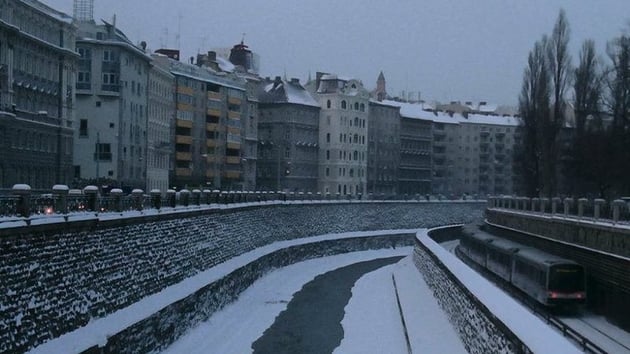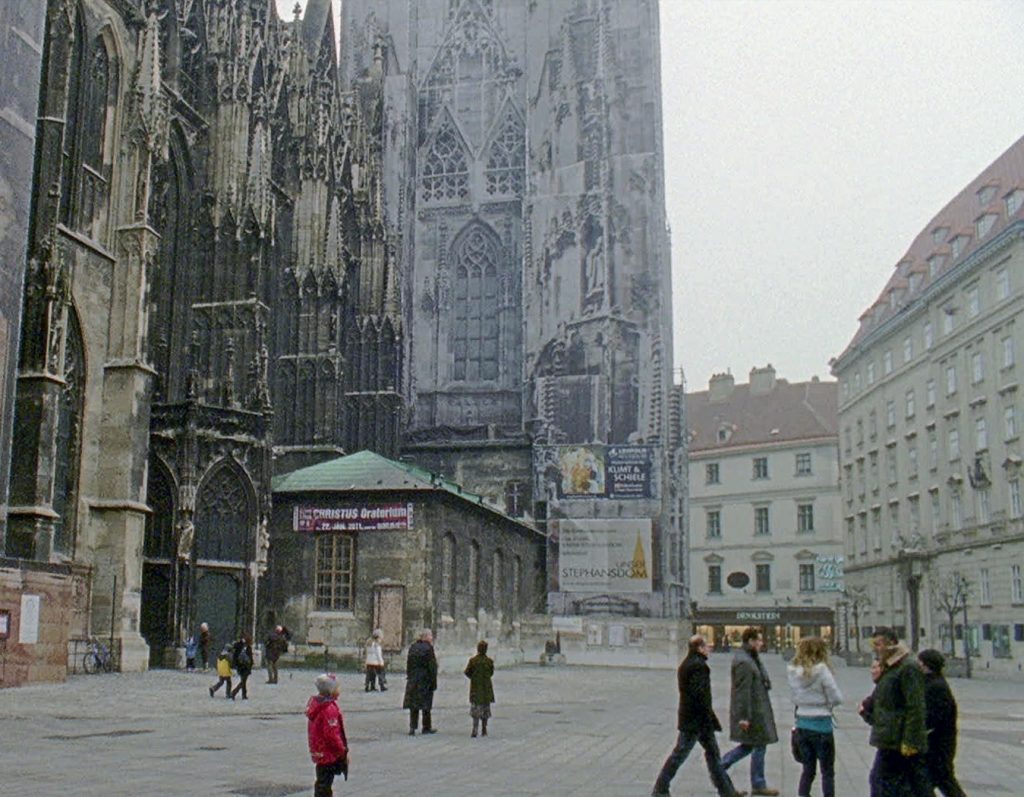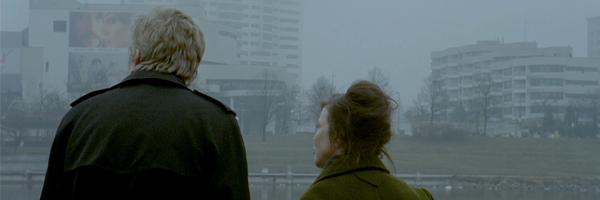It is in Vienna's Kunsthistorisches Museum that the pondering begins in Jem Cohen's Museum Hours. There we meet museum guard Johann (Bobby Sommer) and visitor Anne (Mary Margaret O'Hara), a couple of quiet misfits who strike up a brief friendship while the visitor is in the Austrian capital to attend upon a cousin lying comatose in a city hospital. Johann can tell that Anne is floundering a bit, unfamiliar with the language and layout of his city. He first helps her to decipher a map, but ultimately plays unconventional tour guide, sensitive to her financial limitations. Johann's efforts to find memorable but inexpensive sights for Anne take them to vistas and precincts unknown to the average tourist. This turn of story reflects writer and director Jem Cohen's intention to take us all over the city for our museum hours. It's not simply a matter of examining some great work by Breughel or Rembrandt on the walls of the Kunsthistorisches Museum. It also a little-known waterway cutting through the city, a partially-crushed beer can on the ground, birds perched on wires, or the tracks of a single bird crossing human bootprints in the snow. This and much more.
 The relative silence of the museum has not always been the rule with Johann, now in his sixth year as a guard. In voiceover, he explains that he had in younger years managed a band and subsequently worked in a vocational school where the whine of the saw could frequently be heard. "I had my share of loud. Now I have my share of quiet," he says, as we see images of the museum's art, or Johann sitting or wandering about one of his rooms.
The relative silence of the museum has not always been the rule with Johann, now in his sixth year as a guard. In voiceover, he explains that he had in younger years managed a band and subsequently worked in a vocational school where the whine of the saw could frequently be heard. "I had my share of loud. Now I have my share of quiet," he says, as we see images of the museum's art, or Johann sitting or wandering about one of his rooms.This drift of the camera away from a first image seen when the voiceover begins, or away from the figures of Johann or Anne as they speak is frequently the case in Museum Hours. It is as if the film itself has a consciousness away from its ostensible subjects. This drifting consciousness does not seem a matter of a short attention span, nor even restlessness, but reflects a tendency to be encompassing or inclusive. And that without being indiscriminate in presenting its images; a graceful balance that Museum Hours maintains throughout.
In their first conversation, as Johann tries to help Anne get her bearings with a map of Vienna, he also offers to be of what help he can (he had already told us as much about himself; a simple tenet of the gentle man's philosophy), whether that entails further directions, or playing translator for Anne with her relation's German-speaking doctor. Johann admits (to us) that he offers to speak to the doctor partially to make sure the stranger's story is true.
 Anne does subsequently ask Johann to speak to a doctor on the phone and even accompany her to the hospital. "Why not," he says, the easy-going assent essentially another simple expression of his outlook. As the two are enveloped in the silence of the hospital room, their brief relationship is granted a kind of accelerated intimacy. Before they leave the room, Anne asks Johann to talk about some of the paintings in the museum to the comatose woman. After he speaks of Rembrandt, she asks him to talk about a painting that has Christ as a subject. "That might get a rise out of her," she says. By the time we see them sitting elsewhere in the hospital, the relative strangers seem like old friends, their ease expressed in the slouch of their weary bodies against a wall and toward one another.
Anne does subsequently ask Johann to speak to a doctor on the phone and even accompany her to the hospital. "Why not," he says, the easy-going assent essentially another simple expression of his outlook. As the two are enveloped in the silence of the hospital room, their brief relationship is granted a kind of accelerated intimacy. Before they leave the room, Anne asks Johann to talk about some of the paintings in the museum to the comatose woman. After he speaks of Rembrandt, she asks him to talk about a painting that has Christ as a subject. "That might get a rise out of her," she says. By the time we see them sitting elsewhere in the hospital, the relative strangers seem like old friends, their ease expressed in the slouch of their weary bodies against a wall and toward one another.Even before Johann begins to lead Anne on their unconventional sightseeing, the tone is set with the visitor's arrival quietly heralded by the tower of the Vienna airport in a pool of water speckled with bits of rubbish. Both the drift and inclusiveness of Cohen's film is also signaled early on as Johann speaks of his attention to seemingly innocuous objects in paintings, "...discarded playing cards, a bone, a broken egg, a cigarette butt, a folded note, a lost glove, a beer can..." Seamlessly, we're taken from a museum gallery to a frigid bit of Vienna ground; the first three items at the base of a painting hung in the museum, the list proceeding with objects observed outdoors.
Mr. Cohen shows a particular fondness for the sight and movements of birds. A painting of a winter scene, blackbirds on bare branches against a cobalt sky gives to a one outdoors, a similarly dark-feathered bird atop a rusty metal pole, foregrounded by the fine, stiff veins of a tree bared of leaves.
Cohen's penchant to document the seemingly non-scenic, to at least avoid the easy beauty of the Austrian capital, as well as the almost unwavering gray canvas of the winter skies, might well come across an arch move in a film less open, less generous in its outlook. But there is little about Museum Hours which smacks of facile punk gesture. No flowers cast conspicuously in the sludge of dirt and melted snow.
The drift of Museum Hours extends beyond visual milieu of Vienna to the social, remnants of its sometimes unsavory past which echo into the present. Consistent with the tone throughout, this occurs gently, elliptically, through the calm voice of Johann. He brings Ann to the blocky Judenplatz Holocaust Memorial and says, "It was very controversial when they built it....The spines of the books are all turned away. And to me the pages are like the Jews that were killed." As the two converse in a bar, we hear without segue, "Nowadays it's like the whole country is shifted towards the right. And so it's much more serious in a way...it's like...the young people are voting right." When Anne later asks Johann to explain the spears she has observed placed before numerous shops, he first makes up a story about shopkeepers defending the city from the threat of invading Turks in the 17th century. After Anne facetiously thanks him for the history lesson, Johann adds, "Apart from that, you know, there's still many people who are a little too worried about Turkish invasions here."
But Museum Hours does not define itself in negative terms. As counterpoint to the more regrettable chapters of its history, past or being written, one of the bars to which Johann takes Anne operates on the same inclusive terms as the film. One of the bar's patrons, who looks like he might well be a Turk himself, explains, "And on Sundays, for example, there's an immigrant's party here that we love...."
During their earliest scenes together, both Sommer and O'Hara actually seem like non-professional actors. This is neither far from the truth nor a detriment to Museum Hours. Sommer's only previous experience on film was as a reader (apparently) in Cohen's Evening's Civil Twilight in Empires of Tin (2008). O'Hara has done some acting over the years, mainly in short films. The lack of polish or fluidity only serves to lend a sense of reality to the feeling out of their first exchanges. The halting conversation (particularly that of O'Hara) suits the awkwardness of the early encounters as a friendship is established between Anne and Johann.
Ms. O'Hara is several scenes into Museum Hours before seen facing the camera. Cohen often shoots her at an angle, or from behind, as is the case the first time we see her, making a phone call to her sister to announce the trip to Austria and borrow money. Anne herself is the sister of Catherine O'Hara. While the hair - usually piled atop her head and streaming down a bit rebelliously - is brunette to Catherine's blonde, the faces (heart-shaped, full cheeks, deep-set almond eyes) and particularly the voices are of a set - voices expressed through such a distinctive, broken and alluring cadence.
Before Museum Hours, Anne O'Hara was better known as a singer and songwriter. Cohen makes use of that unique talent, though like much else, this occurs gradually, without fanfare. We do hear Anne singing to her comatose cousin on a couple of occasions in the hospital. But it is near film's end, when Anne is in her small hotel room, that we really hear her break into song (a very apt figure of speech for this particular voice). This occurs just before she quits the sterile hotel and the city, her cousin having finally died. Shot mainly from behind in the dark room, framed by a window that gives only to a bleak building back of blotchy cement and a few metal-framed windows, O'Hara sings her own, "Dark Dear Heart." When she carries notes, as with the line, "Why in the darkness do I see so clearly," that "so" becomes a kind of plaintive warble. It's a moving moment, all the more so for the emotional restraint which defines so much of Museum Hours. O'Hara becomes another darkly-plumed bird for Cohen's collection.
For all its drift away from the art on display in the Kunsthistorisches Museum, there's no lack of reverence for the great works. Again, there is none of the punk gesture - or in terms of film history, the childish trashing of most all earlier French film by Nouvelle Vague auteurs - of dismissing everything that has come before to make space for one's insecure self or vision. Mr. Cohen's point does not seem to be that all objects are equally beautiful, that the crumpled beer can is as valuable as the late-Rembrandt, but that we should simply feast our eyes both within and beyond the frames towards which they are usually directed.
This point is made within the context of appreciating some of the very recognizable art on the museum's walls, These in Johann's favorite room, full of works by Pieter Brueghel the Elder. A museum guide (Ela Piplits) tries, without complete success, to get her group to consider that the title and ostensible subject of the paintings might not actually be Brueghel's focus.
Not surprisingly, there is no tearful goodbye for Anne and Johann. At least none to which we are privy. The last we see of them together is after the news of the death of Anne's cousin, enjoying the fellowship of that friendly, aforementioned bar, presumably on a Sunday night with the "immigrant's party" in full swing.
Cohen concludes his film by making explicit a point he has made with subtlelty throughout. It's hardly necessary, but consistent with a work that for all its quiet, all its apparent restraint, presents its themes in such an inclusive, openhearted manner. Johann narrates a scene as if describing one of those Bruegel paintings. But we're no longer in the Kunsthistorisches Museum. We observe a seemingly banal scene as an old woman walks up a sidewalk and out of sight as oblivious traffic flows to the left. As has often been the case, this it not tourist Vienna, not a part of the city a visitor is likely to regard once, much less twice. And yet, we see it as a painting come to life, full of possible interpretation and pathos, not to mention "...the bright red taillights of the cars on the left, which seem impossibly red and even beautiful." The point made explicit? Museum hours occur everywhere, all the time. Look about you.
db







Comments
Post a Comment